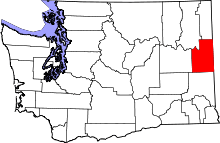2011 Spokane bombing attempt

The Spokane bombing attempt occurred on January 17, 2011, when a radio-controlled-shaped pipe bomb was found and defused in Spokane, Washington along the route of that year's Martin Luther King Jr. memorial march.
On March 9, 2011, the Federal Bureau of Investigation (FBI) arrested Kevin William Harpham, 36, of Addy, Washington. On December 20, 2011 he was sentenced to 32 years in prison for the attempted bombing.
Details
According to the FBI, the bomb was a "viable device" that could have sprayed marchers with shrapnel and caused multiple casualties; it also contained rat poison to prevent bleeding wounds from coagulating.[1] According to the FBI, the bombing may have been racially motivated, and its timing was likely not a coincidence.[2] The New York Times said that the bomb had been reported to police at roughly 9:25 a.m. that morning.[3]
The bomb was found in a Swiss Army brand[4] backpack that also contained two T-shirts. One of the shirts mentioned a rally against cancer in Stevens County, Washington, while the other mentioned a 2009 play put on by students at Chewelah, Washington high school (also in Stevens County).[5][6][7] Police sent bomb-sniffing dogs, a robot, and specially trained officers to the location where the bomb was found.[3] After the bomb was defused, the backpack was sent to the Federal Bureau of Investigation laboratory in Quantico, Virginia for further analysis.[7] According to the Rev. Percy "Happy" Watkins, most people at the march did not know about the bomb threat at the time it happened.
Police investigation and trial
The FBI offered a $20,000 reward for any information leading to the capture of those responsible.[2]
On March 9, 2011, the FBI arrested Kevin William Harpham, 36, of Addy, Washington, in connection with the bombing attempt. Harpham allegedly had ties to the National Alliance, a white supremacist organization.[8][9][10]
On May 3, 2011, Harpham's lawyers requested a four-month delay in his federal trial for attempted use of a weapon of mass destruction, contending that Harpham faced up to life in prison and they would need more time to prepare. Harpham had pleaded not guilty, and remained in jail without bail from the time of his arrest.[11] On May 20, 2011, U.S. District Judge Justin Quackenbush agreed to delay Harpham's trial until August 22, 2011.
Documents made public revealed the bomb had a "welded blast plate" and contained shrapnel. The shrapnel was further combined with an anticoagulant rat poison apparently intended to prevent any resulting wounds from clotting.[12]
On September 14, 2011, Harpham pleaded guilty to setting the device,[13] but on December 20, 2011, hours before he was due to be sentenced, Harpham tried to withdraw his guilty plea, claiming that the device in his backpack didn't meet the legal definition of a bomb.
After rejecting the request and expressing disbelief at Hapham's claim that the device was not intended to hit parade-goers, Quackenbush sentenced him to 32 years in prison, followed by supervised release for life. He will also be required to complete counselling.[14] He is serving his sentence at Federal Correctional Institution, Herlong in Herlong, California.
See also
References
- ↑ Winter, Michael (January 27, 2011). "MLK Day bomb in Spokane contained rat poison, shrapnel". USA Today.
- 1 2 "FBI: Pipe Bomb Found On MLK Parade Route".
- 1 2 Yardley, William (January 18, 2011). "Bomb Is Found in Backpack Before March Honoring King". The New York Times.
- ↑ Bates, Daniel (January 19, 2011). "Bomb that could have killed hundreds found by police on Martin Luther King parade route". Daily Mail. London.
- ↑ "Shirts found with Wash. MLK parade bomb are local". The Washington Post.
- ↑ "Pipe Bomb discovered along MLK parade route".
- 1 2 "FBI: Bomb along MLK Day parade route could have been 'pretty lethal'". CNN. January 19, 2011.
- ↑ "Suspect in MLK bomb tied to racist movement". The Spokesman Review. Retrieved March 9, 2011.
- ↑ Richie, Warren (December 20, 2011). "Failed Martin Luther King Day parade bomber gets 32-year sentence". Christian Science Monitor. Retrieved 14 February 2012.
- ↑ "Bomb suspect tied to supremacist group". Boston Globe. March 10, 2011. Archived from the original on September 9, 2011. Retrieved 14 February 2012.
- ↑ Associated Press. "Harpham's attorneys ask for a four month delay in MLK bomb trial". Krem2 News. King Broadcasting Company. Retrieved 2011-05-03.
- ↑ "Bomb plot trial delayed till August". The Spokesman Review. Retrieved May 26, 2011.
- ↑ Craig, John (2011-09-08). "Harpham admits guilt in bomb plot". The Spokesman-Review. Retrieved 2012-01-14.
- ↑ "MLK Bomber Harpham Gets Max Sentence: 32 Years". KHQ-TV. 2011-12-20. Retrieved 2012-01-14.